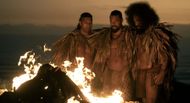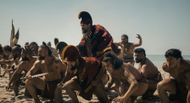Apple TV+’s Chief of War is by and large based on authetic Hawaiian history, but episode seven, titled Day of Spilled Brains, goes beyond anything the series has attempted before. Jason Momoa, who co-created the show and stars as Ka’iana, based the installment on a devastating event from the late 18th century known in Hawaiian as Kalolopahu.
The episode shows Captain Simon Metcalfe and his crew, angered after a trade rejection, filling their cannons with nail bombs and firing on innocent villagers. Hundreds were slaughtered, and the horrifying sequence is presented not as fictional drama but as a reconstruction of a massacre that still carries weight in Hawaiian memory.
Series co-creator Thomas Pa’a Sibbett tells The Hollywood Reporter that the massacre at Olowalu was "real," while Momoa describes the tragedy as the “ultimate horror.”
By grounding Ka’iana’s journey in this violent turning point, the show underlines the urgency of his warnings about foreign intrusion. The episode’s title comes directly from how Hawaiians themselves remember the event: a literal "Day of Spilled Brains".
Chief of War: Jason Momoa connects Day of Spilled Brains to Hawaii’s real tragedy

Episode 7 of Chief of War takes its title, Day of Spilled Brains, from the Hawaiian phrase Kalolopahu, which refers to the real massacre at Olowalu in the late 1700s. The event unfolded when American sea captain Simon Metcalfe, angered after his trade offer was turned down by Kamehameha I, retaliated against ordinary Hawaiians.
Instead of leaving peacefully, he ordered his crew to load their cannons with makeshift shrapnel - nails and bits of metal - and fired into a bay crowded with villagers. The attack wiped out entire families in seconds. It was not a battle between armies but an indiscriminate slaughter, and the trauma of that day still lingers in Hawaiian history.
Jason Momoa and co-creator Thomas Pa’a Sibbett made sure the show did not dilute the horror of what happened. They chose to depict the massacre from Ka’iana’s perspective, even though historically he was not present at the site. For them, this was not about rewriting history but about making the character embody the helplessness of watching his worst warnings come true.
Momoa has said Ka’iana represents a chief who understood early on how dangerous foreign powers could be, only to have his fears dismissed. Seeing the massacre unfold in front of him underlines his frustration and sense of futility.
Sibbett explains that the creative team condensed events for storytelling purposes but kept the essence intact. In reality, Hawaiians had paddled out in canoes and were gunned down in the water.
The series adjusted the story so the gunfire attack happened onshore, making filming possible while still honoring the historical record. They also consulted with local tribes in New Zealand, where the scene was shot, to ensure cultural sensitivity in staging such a violent sequence.

The episode depicts what was an act of "ultimate horror" for Ka’iana. He had traveled the world, seen slavery and exploitation firsthand, and had tried to convince his people that outsiders would bring destruction. Instead, he had been silenced by laws and traditions that prevented him from acting against Metcalfe.
The Olowalu massacre becomes the moment where Ka’iana’s warnings are proven right, yet it costs countless lives. By including this episode, Chief of War acknowledges a painful chapter that is often overlooked in American history. The show recreates the tragedy not just from the story point but as a reminder of how colonization arrived violently on Hawaiian shores.
Follow Soap Central for more updates.
